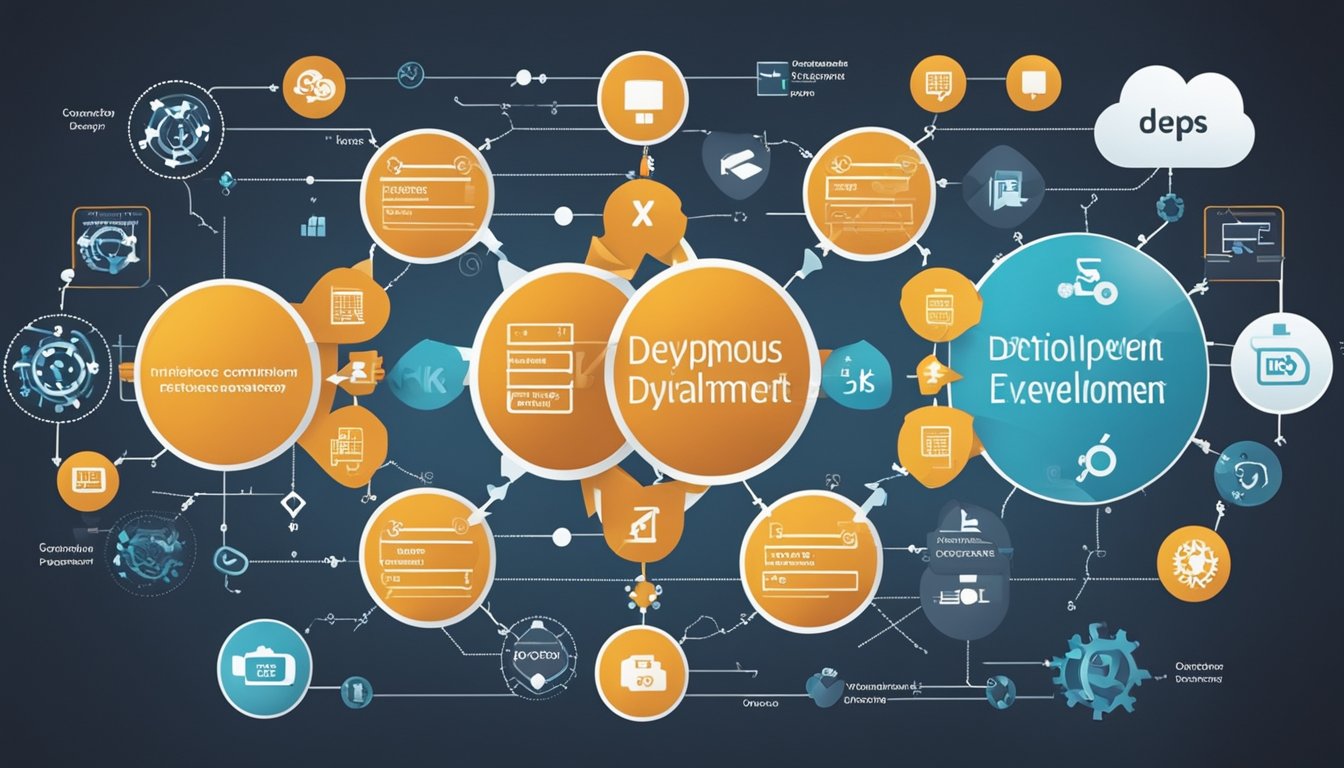Best Practices CICD with Micro ServiDevOps A Comprehensive Guide
As software development teams strive to deliver software faster and more efficiently, Continuous Integration and Continuous Deployment (CI/CD) has become an essential practice in software development. In the context of microservices architecture, CI/CD is even more crucial as it allows teams to work independently, deploy and scale individual services, and deliver software updates more frequently. In this article, I will discuss best practices for implementing CI/CD in microservices architecture and the role of DevOps tools and techniques in this process.

Understanding CI/CD in microservices architecture is essential to ensure that each service is deployed and scaled independently of other services. CI/CD pipeline plays a vital role in automating the software delivery process and ensuring that the code is tested, built, and deployed continuously. Best practices for CI/CD implementation in microservices architecture include incorporating testing into the pipeline, unit testing, integration testing, and end-to-end testing. Additionally, load balancing, service discovery, and version control are typical problems encountered when implementing CI/CD in microservices architecture.
Key Takeaways
- CI/CD is essential in microservices architecture to allow teams to work independently, deploy and scale individual services, and deliver software updates more frequently.
- Best practices for CI/CD implementation in microservices architecture include incorporating testing into the pipeline, unit testing, integration testing, and end-to-end testing.
- DevOps tools and techniques play a vital role in CI/CD implementation in microservices architecture, and advanced deployment strategies such as blue-green deployment and canary release help to minimize downtime and reduce risk.
Understanding CI/CD in Microservices Architecture

As a DevOps engineer, I understand that implementing Continuous Integration/Continuous Deployment (CI/CD) in a microservices architecture can be a challenging task. Microservices architecture is a method of developing software systems where an extensive application is broken down into smaller, independent services that communicate with each other through APIs. Each microservice runs its process and can be developed, deployed, and scaled independently.
Continuous Integration (CI) is the process of frequently merging code changes into the main branch. Automated build and test processes ensure that code in the main branch is always production-quality. Continuous Delivery (CD) is the process of continuously pushing code changes through the pipeline to prepare them for deployment. Continuous Deployment (CDp) is the process of automatically deploying code changes to production after they pass testing.
In microservices architecture, CI/CD pipelines must be designed to support the infrastructure and deployment needs of each microservice. Each microservice requires its own pipeline to ensure that the changes made to the service are properly tested, integrated, and deployed. The pipeline should be designed to handle the specific needs of each microservice, such as language, framework, and infrastructure.
To ensure that the CI/CD pipeline is efficient and effective, it is essential to automate as many processes as possible. This includes automated testing, deployment, and monitoring. Automated testing ensures that code changes are thoroughly tested before they are deployed to production. Automated deployment ensures that code changes are deployed quickly and efficiently, reducing the risk of errors and downtime. Automated monitoring ensures that the system is running smoothly and that any issues are quickly identified and resolved.
In summary, implementing CI/CD in a microservices architecture requires careful planning and design. Each microservice requires its own pipeline, and the pipeline should be designed to handle the specific needs of each microservice. Automation is essential to ensure that the pipeline is efficient and effective, including automated testing, deployment, and monitoring.
Best Practices for CI/CD Implementation

As a DevOps engineer, I have found that implementing CI/CD with Micro ServiDevOps can be challenging without following best practices. Here are some best practices that I have found to be effective:
Automated Testing
Automated testing is a crucial part of CI/CD implementation. It helps to ensure that the codebase is reliable and that the build process is automated. Unit tests, integration tests, and end-to-end tests are essential for ensuring that the software development process is robust and that the software is of high quality. It is also important to perform load testing and performance metrics to ensure that the software is scalable and can handle high traffic.
Version Control
Version control is critical for CI/CD implementation. It allows developers to collaborate on code changes and track changes over time. It is important to have policies in place for version control and to ensure that access control is in place to prevent unauthorized changes.
Release Pipeline
A release pipeline is a series of automated processes that move code changes from development to production environments. It is important to have quality gates in place to ensure that code changes meet the necessary requirements before moving to the next stage of the pipeline. Shift left testing is also important, which means testing earlier in the software delivery lifecycle.
Automation and Monitoring
Automation and monitoring are key to successful CI/CD implementation. It is important to have automated processes in place for deployment, testing, and quality check. Monitoring is also important to ensure that the software is performing as expected in production environments. It is important to have metrics in place to measure the cycle time and test coverage.
Security
Security is an essential aspect of CI/CD implementation. It is important to ensure that the software is secure and that access control is in place. Configuration files should be encrypted, and the software should be containerized to ensure isolation. Manual approval should also be required for changes that affect the production environment.
In conclusion, following best practices for CI/CD implementation can help to ensure that the software development process is efficient, reliable, and agile. By implementing automated testing, version control, release pipeline, automation and monitoring, and security, organizations can achieve faster release cycles and independent deployments.
Role of DevOps Tools and Techniques in CI/CD

As a DevOps engineer, I understand the importance of using the right tools and techniques to ensure successful CI/CD pipelines. In this section, I will discuss the role of various DevOps tools and techniques in the CI/CD process.
Git
Git is a popular version control system that plays a crucial role in the CI/CD process. It allows developers to easily collaborate on code, track changes, and revert to previous versions if necessary. Git also enables continuous integration by triggering builds automatically when changes are pushed to the repository.
Kubernetes
Kubernetes is a popular container orchestration platform that simplifies the deployment and management of containerized applications. It provides a scalable and reliable infrastructure for running microservices, which is essential for successful CI/CD pipelines.
Helm
Helm is a package manager for Kubernetes that simplifies the deployment of applications and services. It allows developers to define and manage their Kubernetes applications as charts, which can be easily installed, upgraded, and rolled back.
AKS
Azure Kubernetes Service (AKS) is a fully managed Kubernetes service provided by Microsoft Azure. It allows developers to easily deploy and manage containerized applications on a large scale, making it an ideal platform for CI/CD pipelines.
GitOps
GitOps is a modern approach to continuous delivery that uses Git as the single source of truth for infrastructure and application deployments. It enables developers to manage their infrastructure as code, making it easier to track changes and maintain consistency across environments.
Credentials
Credentials management is critical for secure and successful CI/CD pipelines. DevOps engineers must ensure that credentials are stored securely and not exposed to unauthorized users. Tools like HashiCorp Vault and Azure Key Vault can help manage and secure credentials.
Docker
Docker is a popular platform for building, shipping, and running containerized applications. It provides a consistent and reliable environment for running microservices, which is essential for successful CI/CD pipelines.
Jenkins
Jenkins is an open-source automation server that is widely used for continuous integration and continuous delivery. It provides a flexible and extensible platform for building, testing, and deploying applications.
Kubernetes Cluster
A Kubernetes cluster is a group of nodes that run containerized applications. It provides a scalable and reliable infrastructure for running microservices, which is essential for successful CI/CD pipelines.
Monorepo
A monorepo is a software development strategy where multiple projects are managed within a single repository. It enables developers to share code and dependencies across projects, making it easier to maintain consistency and reduce duplication.
Docker Image
A Docker image is a lightweight, standalone, and executable package that contains everything needed to run a piece of software, including code, libraries, and dependencies. It plays a crucial role in the CI/CD process by providing a consistent and reliable environment for running microservices.
Build Artifacts
Build artifacts are the output of the build process, including binaries, libraries, and other files. They are essential for successful CI/CD pipelines, as they provide a reliable and consistent way to deploy applications across environments.
In conclusion, DevOps tools and techniques play a crucial role in the CI/CD process. They enable developers to build, test, and deploy applications quickly and reliably, while ensuring consistency and security across environments. By using the right tools and techniques, DevOps engineers can ensure successful CI/CD pipelines and deliver value to their customers faster.
Advanced Deployment Strategies

When it comes to deploying microservices, there are several advanced strategies that can help streamline the process and minimize downtime. Here are some of the most popular strategies:
Canary Release
Canary release is a deployment strategy that involves rolling out new features to a small subset of users before releasing them to the entire user base. This allows you to test the new features in a real-world environment and catch any issues before they affect a large number of users. To implement canary release, you'll need to use a feature flagging system that allows you to turn features on or off for specific users or groups.
A/B Testing
A/B testing is another deployment strategy that involves testing two different versions of a feature to see which one performs better. This is usually done by randomly assigning users to one of the two groups and measuring the performance of each group. A/B testing can be used to test everything from UI changes to pricing strategies.
Blue-Green Deployment
Blue-green deployment is a strategy that allows you to deploy a new version of your application alongside the old version, and then switch traffic over to the new version once it's ready. This minimizes downtime and allows you to quickly roll back to the old version if there are any issues. To implement blue-green deployment, you'll need to have two identical environments (blue and green) that can be switched back and forth.
Release Train
Release train is a strategy that involves releasing new features on a regular schedule, such as once a week or once a month. This helps ensure that new features are delivered on a predictable schedule and makes it easier to plan releases. To implement release train, you'll need to have a well-defined release process and a team that is committed to delivering new features on a regular basis.
Feature Branches
Feature branches are a strategy that involves creating a separate branch for each new feature or bug fix. This allows developers to work on features independently without interfering with each other's work. Once a feature is complete, it can be merged back into the main branch. To implement feature branches, you'll need to have a version control system that supports branching and merging.
VPNs
VPNs are a strategy that involves using a virtual private network to securely connect different environments and allow developers to access resources from anywhere. This is especially useful for remote teams or teams that work across different locations. To implement VPNs, you'll need to have a VPN service provider and a team that is familiar with setting up and configuring VPN connections.
Overall, these advanced deployment strategies can help you streamline your deployment process, minimize downtime, and deliver new features more quickly and reliably. By choosing the right strategy for your team and your application, you can ensure that your microservices are deployed in a way that is both efficient and effective.
Frequently Asked Questions

What are some best practices for implementing CI/CD with microservices?
When implementing CI/CD with microservices, it is important to follow some best practices to ensure success. Here are some recommendations:
- Use a version control system to manage your codebase
- Automate your build, test, and deployment processes
- Use containerization to ensure consistency between development and production environments
- Implement monitoring and logging to detect and troubleshoot issues
- Use a tool like Kubernetes to manage your microservices and automate deployment
How does Kubernetes fit into CI/CD for microservices?
Kubernetes is a popular tool for managing microservices and automating deployment. It can be used as part of a CI/CD pipeline to automate the deployment of microservices. Kubernetes can also be used to manage the scaling and availability of microservices, ensuring that they are always up and running.
What are some common challenges when implementing CI/CD for microservices?
Implementing CI/CD for microservices can be challenging. Some common challenges include:
- Managing multiple code repositories and version control systems
- Ensuring consistency between development and production environments
- Managing dependencies between microservices
- Implementing effective monitoring and logging
- Managing the complexity of deploying and scaling microservices
How can Helm be used in a CI/CD pipeline for microservices?
Helm is a popular tool for managing Kubernetes applications. It can be used in a CI/CD pipeline for microservices to automate the deployment of applications to Kubernetes. Helm can be used to package microservices into charts, which can be easily deployed to Kubernetes.
What are some recommended tools for CI/CD with microservices?
There are many tools available for implementing CI/CD with microservices. Some recommended tools include:
- Jenkins: A popular open-source tool for automating CI/CD pipelines
- GitLab: A web-based Git repository manager that includes built-in CI/CD
- CircleCI: A cloud-based CI/CD platform that integrates with GitHub and Bitbucket
- Spinnaker: An open-source tool for deploying and managing applications in cloud environments
What are some benefits of implementing CI/CD in a microservices architecture?
Implementing CI/CD in a microservices architecture can provide many benefits, including:
- Faster time to market for new features and updates
- Improved quality and reliability of software releases
- Increased efficiency and productivity of development teams
- Better visibility into the software development process
- More effective collaboration between development and operations teams

We are committed to delivering a new level of automation that will help organizations save time, money, and staffing resources.
 WRITE FOR US!
WRITE FOR US!
